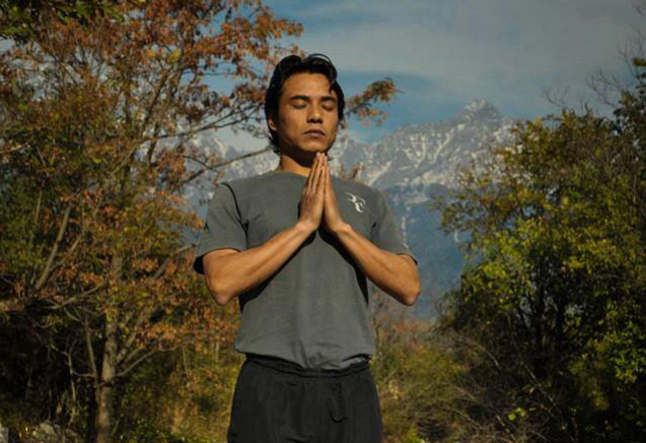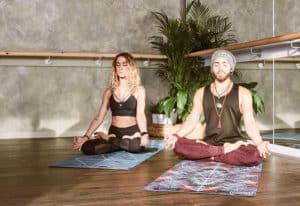an exclusive interview with surendra – part 1

from yog to yoga
I had an inspiring morning talking to Surendra about yoga and life.
Surendra is a meditation, yoga philosophy and sound healing teacher based in Rishikesh, Uttarakhand, India. Surendra left a successful career as an electrical engineer to pursue his passion for yoga. He has completed studies at Kaivalyadhama Yoga Institute and Dev Sanskriti Vishwavidyalaya and is currently a meditation and sound healing instructor at Samidha Healing.
Over chai tea and the great view of the Ganges, we spoke for hours about yoga as an ancient science in the modern world, the shift from traditional yog to yoga, and why it all matters. Grab some chai and read on to gain Surendra’s perspective on yoga and life in part one of a two-part interview.
Laura Heggs for YOGI TIMES: Okay, so how did you first get into yoga?
Surendra: My journey started in 2000. I met a friend and he made me listen to one discourse. It was like a speech.
LH: Like a recorded one with a guru?
Surendra: Yes. I listened to it and after that, I don’t know what happened. I was there listening and went into a deep relaxation. The discourse was only 45 minutes but I awoke 4 hours later.
LH: So it made you go to sleep?
Surendra: Yes. And after that, this was maybe until that time [the year 2000] I never had such deep sleep, such refreshing sleep. So I was like “wow what is this?”
LH: Was it [the discourse] meant to make you go to sleep?
Surendra: I honestly don’t know. I just fell asleep listening to this discourse. I went into such a deep relaxation listening to it that I went into deep sleep. I was looking for meditation since my childhood but never truly discovered it. I was trying but not being from a place with a lot of resources I was unsure what to do. I was always interested in meditation, like what is this, you know?
Then he [my friend] introduced some meditation techniques to me. So since 2000, I have been practicing these different kinds of meditation. My meditation journey started during my first year in engineering- I am trained as an electrical engineer. I was doing my engineering and reading a lot, and, at the same time, doing different kinds of meditation. Ultimately, my inclination was less into engineering and my meditation practice, became the primary objective. I worked very hard, really hard, around 4 years during the electrical engineering program. I was working with myself through different kinds of meditation, reading a lot. Then I passed from this college and had to work. So I started working. And I worked with two multinational companies. And in 2012 I experienced that I am working here, but what is the objective I am fulfilling?
LH: Yes.
Surendra: Because as an electrical engineer, what can I give to society? That would be only electricity.
LH: Like helping to provide infrastructure [by providing electricity].
Surendra: Yes, but for me this is not enough. I thought it has been 12 years since I started practicing, but what else can I do to contribute more and take me deeper into spirituality at the same time. I was on the path, still, I am. Then I discovered yoga school. Until that time, I was practicing yoga, but I was not, you can say the “proper” yoga. I never knew there was a system- Patanjali was there, Hatha yoga is there, Mantra yoga is there. So I was dealing with the cream, the meditation. But whatever was helping me in meditation, I was following them but not understanding the theory behind them.
LH: So you were doing asanas without knowing what they were doing.
Surendra: I never did asanas. I was working with my breathing, sitting silently and following what yoga philosophy says without being aware of the real philosophy. This is a very well designed science
. Then I decided to go to school in 2012 to learn more. From there, I learned the actual philosophical background and systematized science of yoga.The Hatha yoga, the Raja yoga, all of these cleansing processes, asanas, but their main emphasis is not into meditation. The techniques I was practicing, they were not teaching. For them [the school], the meditation is the traditional form: sit for half an hour and be quiet.LH: So what was your friend teaching that was different from the traditional concept?
Surendra: Many different meditations! Like the Kundalini meditation. I practiced for four years, maybe not continuously, but two months here and 10 days there, taking different breaks. I practiced all of these meditations for many years.
LH: So would you do it everyday?
Surendra: Yes everyday. In those four years when I was studying, I would start from 5 AM to 8 AM doing some type of meditation and in the evening from 4 PM to 7 PM. In between, I used to go to my college and study there, and we used to have a meditation hall in Dehradun.
LH: So what kept bringing you back to that kind [moving] of meditation? Because it is one thing to be like “hey, I want to go to sleep” and another to say “man, I’m going to spend 4 hours a day meditating.” So where was that balance for you, when you said I really like this [meditation] speaks to me a lot? What was happening for you? Were you just feeling good or was it helping you find balance?
Surendra: Of course! And that relaxation was something different. I said I never felt such deep relaxation in my life. It triggered something in me. And working with yourself, you get to know all these thoughts running in your mind continuously and you get to work with them. Then you get these small, small gaps in your thinking and you have to work on yourself so you become more aware. So slowly, slowly, with this awareness and with this experience you tend to learn more and more about life and about yourself. You can learn from your experiences also. But when you are by yourself, on your own, closing your eyes and going in, it accelerates the learning process. And learning in the sense that you have many different aspects of spirituality and you learn how to not identify with your thoughts, with your feelings, your body. And slowly this understanding deepens.
This is the real freedom, you know? What yoga is talking about? Freedom from what? Not freedom from the outside world, because everyone has to live here. It is freedom from mind. Actually, freedom is freedom from mind. Not freedom from world, freedom from words, which go on continuously. This is the real freedom. The ‘you learn a lot about yourself and there is no end to it’. You keep on learning. This changed me drastically. Those four years, and all those meditation sessions, that changed me really.
LH: What do you think the top change or changes for you were before and after meditating during those years?
Surendra: It is very difficult to see the change because change is not static, you know? You feel that you have changed. But the next moment, you get some more understanding. And that change doesn’t seem so big. But you say okay, I’m growing. So the growth happens continuously. Like oh, I am better, That “better” has a better than that better. So it goes on happening. One thing I will say is that, in those days, when meditation is happening, so much growth is happening. When meditation is happening, so much is happening.
One part is doing the meditation, then when the benefits happen, you realize what you have. We have so many things and many times it is easy to forget to value them. Like now, we are sitting here in such a beautiful place, but sometimes we are stuck in our minds unable to appreciate the beauty surrounding us. We are running from desire, we think it will fulfill us. But desire never fulfills anybody. It is like putting water in a bucket with no base. You keep on putting the water, and it will never fill up.
LH: True.
Surendra: So meditation and yoga, it doesn’t change anything outside. It changes you, the true you. Once you are changed, your perspective is changed, then you are able to see what the beauty in everything. So with all of the small things, you find how to be happy, how to enjoy.
LH: So do you feel like now, you are the happiest you have been?
Surendra: Maybe the happiest.
LH: Like happiest you have ever been? Ever?
Surendra: Yes it is going up, and it never stops. [laughs]
LH: That is really amazing! A beautiful thing, you know?
Surendra: So for 12 years, of course there was an understanding of yoga, but what yoga has given me, what Patanjali has given me, once you practice you come to know “Oh my god, this is the whole part I have been traveling and this guy has put it in such a beautiful way. In these verses, there is the whole journey. Wow.”
LH: Do you feel like there was anything in Patanjali’s Sutras that took you a long time to grasp? Or do you feel like once you saw it laid out, it was all clear to you?
Surendra: Yeah. I could feel what Patanjali actually meant.
LH: Because you were doing self-study before yoga study?
Surendra: Yes. So the concept was there. And it gives you help. But it is very difficult to find a true master. When you are able to read it and relate yourself and your journey with them, then automatically a kind of trust develops in you. Like it’s not me only, people for thousands of years have been doing this. And it is their testimony, which gives you the confidence. Otherwise, it is not easy to identify these thoughts with your mind. Because right now we are the mind. We don’t have anything else but the mind. So in the beginning when you stop thinking, it seems like you are dying. It is an experience similar to death.
LH: So when that starts happening, it’s a bit scary.
Surendra: Yes. But this is the master key. All yoga, all systems of yoga and spirituality revolves around this idea. They all have different names for different things–some are more body oriented, mind oriented. But you find something that can take you from your situation, where they are. Because everybody is at a different stage. You have to devise the technique, but meditation is the goal.
LH: So with the eight limbed path, you can take the steps or not. Like for you, meditation worked. You didn’t need start with the yamas, niyamas or asanas. Do you feel like people can come to that state in any way?
Surendra: Yes, you don’t need to follow that step by step or do asana. But I am telling you, if you have eaten too much and you try to meditate, of course, you will fall asleep! Yoga has already said don’t eat too much or you will fall asleep in meditation. Once you meditate and you know that you avoid that.
LH: So some people just need coaching on how to improve the technique. Like some people might not know their own body, so they need to start with the asana. But you had this understanding before you began to study?
Surendra: Yes. And when we talk about niyamas, this can come when you start getting to know yourself and experience consciousness in us. The realization comes that consciousness is not only in me, but consciousness is in other people. And compassion comes too. Like earlier, I was so identified with my body and mind, and this is the situation with other people too.
Behavior reflects this. If a person doesn’t know [about the yoga path] you can understand by his behavior. He doesn’t have this perspective on life, he doesn’t have this experience. Instead of getting, let’s say violent, you have compassion toward the person. So you are automatically following the nonviolence. And this is not practiced–it has come to you through your experience and understanding. The truthfulness. Why would you lie?
If we are all the same, we are having this journey of life, there is no difference between you and other people. So there is no need to be untruthful. This understanding slowly, slowly comes. You get to know your experience when you follow these yamas, these restrictions. You also feel that it helps you in your mediation.
LH: So you feel like that comes really naturally?
Surendra: It does, but you have to work. You have to work on your other limbs of yog like yamas and niyamas. It will help you go deeper into meditation. If you work on meditation, it will help you to go deeper into the other limbs as well. Then it won’t be like a rule. It’s not like “Oh, I have to be nonviolent”, it is just like a flower that blossoms and smells. When the understanding in you happens, you are naturally not violent. It’s a part of your life. Initially, you may have to practice, but you should not force anything. It should be a clear understanding why they are there and why they are practiced.
LH: Do you think over time, you practice and it will integrate, not necessarily because your practice is making the difference, but the mediation is driving it?
Surendra: Yes. Then you don’t practice yog. Yoga is your life. There is no other life.
LH: So is that how you feel about your life? Like, do you feel like yog is your life?
Surendra: Yes. So we don’t have a separate life now. Of course, we are not perfect. But the sense is there, that whatever we do, the limbs, the niyamas and yamas, automatically get integrated in your life. Whenever you have to make a decision, automatically inside you might have a duality, like what should I do or not do? Automatically you prefer to go toward these guidelines. Automatically, you tend to follow them.
LH: I like that. Because the way that I have read it and been taught is that it is sequential is that it starts with the yamas, you know? Like start here. And I think that is more a cultural bias like we are taught to think in a linear way.
Surendra: They are not steps, they all go together.

This is part one of a two part interview with Surrendra. Read the second part of the interview here.








